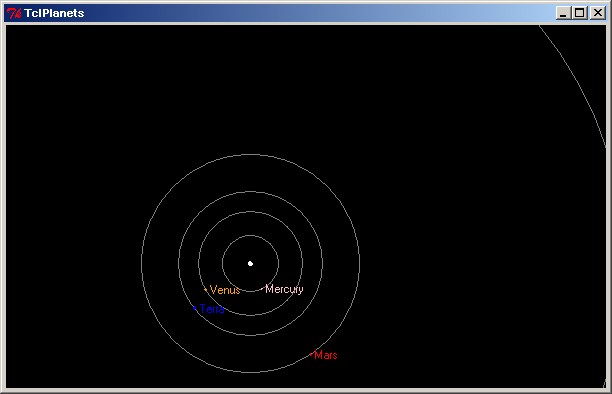TclPlanets
Jeff Smith 2019-06-19 : Below is an online demo using CloudTk
A starkit of this code is available on sdarchive.
Richard Suchenwirth 2002-11-10: This educational Tcltoy shows the solar system on a canvas, with some info displayed in the title bar when you mouse over a planet (or its orbit, which are constantly shown). Zoom in with left, out with right mouse button. Very simple, but enjoy - comment - improve!
package require Tk
# Fundamental planet data:
# Name eq.diameter mass orbit distance color
set data {
Mercury 4840 0.053 .24 58 pink
Venus 12400 0.815 .62 108 orange
Terra 12757 1.0 1.0 149.6 blue
Mars 6790 .107 1.88 228 red
Jupiter 142800 318 11.86 778.3 brown
Saturn 120800 95.22 29.46 1428 yellow
Uranus 52400 14.54 84.02 2872 bisque
Neptune 44600 17.23 164.79 4501 gold
Pluto 3000 .07 249.17 5912 purple
}
foreach {name dia mass orbit distance color} $data {
foreach column {dia mass orbit distance color} {
set g($name,$column) [set $column]
lappend g(planets) $name
}
}
array set g {Sun,dia 1392000 Sun,mass - Sun,orbit 0 sun,distance 0}
proc movePlanets {w} {
global g
foreach planet $g(planets) {
foreach {x0 y0 x1 y1} [$w coords $planet:] break
set x [expr {($x0+$x1)/2.}]
set y [expr {($y0+$y1)/2.}]
set rad [expr {hypot($y,$x)}]
set ang [expr {atan2($y,$x)+.003/$g($planet,orbit)}]
set x2 [expr {$rad*cos($ang)}]
set y2 [expr {$rad*sin($ang)}]
$w move $planet: [expr {$x2-$x}] [expr {$y2-$y}]
$w move $planet- [expr {$x2-$x}] [expr {$y2-$y}]
}
}
proc every {ms body} {eval $body; after $ms [namespace code [info level 0]]}
proc planetInfo {w tags} {
global g
regsub -all {[^A-Za-z]} [lindex $tags 0] "" p
set title {}
set title "diameter: $g($p,dia) km mass: $g($p,mass)"
append title " orbit(yrs): $g($p,orbit)"
return "$p: $title"
}
set tcl_precision 17
pack [canvas .c -bg black -width 600 -height 600] -fill both -expand 1
set s 0.3
.c create oval -$s -$s $s $s -fill white -outline white -tag "Sun info"
foreach planet $g(planets) {
set r [expr $g($planet,distance) * 0.06]
set color $g($planet,color)
.c create oval -$r -$r $r $r -outline grey50 -tag "$planet track info"
set radius [expr $g($planet,dia)*0.00001]
#if {$radius<.1} {set radius .1} ;# make the little ones visible
.c create oval -$radius [expr $r-$radius] $radius [expr $r+$radius]\
-tag "$planet $planet: info" -fill $color -outline $color
.c create text $radius $r -anchor w -text " $planet" \
-fill $color -tag $planet-
}
.c config -scrollregion [.c bbox all]
.c bind info <Enter> {wm title . [planetInfo .c [.c gettags current]]}
.c bind info <Leave> {wm title . "TclPlanets"}
bind . <1> {.c scale all 0 0 2 2}
bind . <3> {.c scale all 0 0 .5 .5}
every 40 {movePlanets .c}
From the Tcl chatroom:
am Re TclPlanets: an (amateur) astronomer would probably complain that the orbits are NOT circles, but rather ellipses tick :1037091601: 09:00 GMT, Tuesday, 12 November 2002
suchenwi Arjen - right! But my physics dictionary says that circles are a close approximation, and I only had one radius per planet. But feel free to improve it!
am Richard, it would not show up (i.e. probably less than 1 pixel), except for the outer planets, Neptune and Pluto at least
I have since been taught that such a solar system model is called an "orrery", and a much fancier version in Java is e.g. at http://www.schoolsobservatory.org.uk/uninow/orrery/ (but it probably took them more than 1.5 pages of code...)
pdh: Nice work. I believe "Neptun" should be "Neptune". RS: Thanks, fixed - this was imperfectly translated from a German school atlas...
